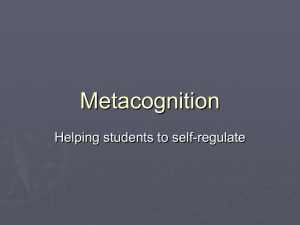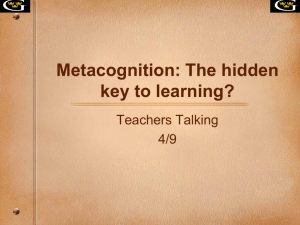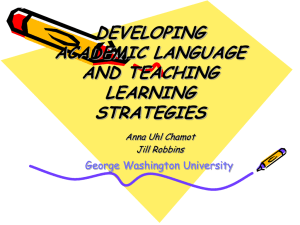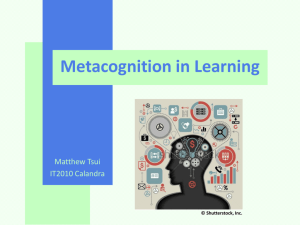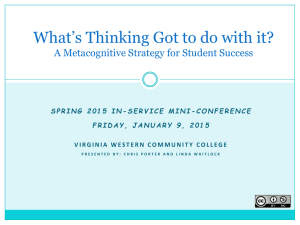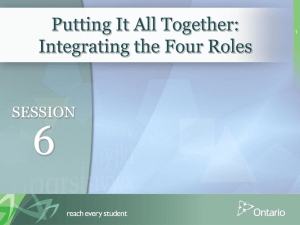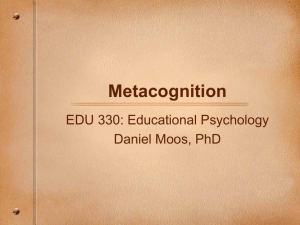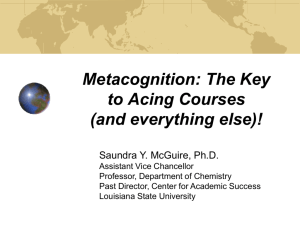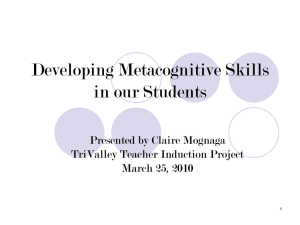MultiMedia Presentation GED624 Final2
advertisement
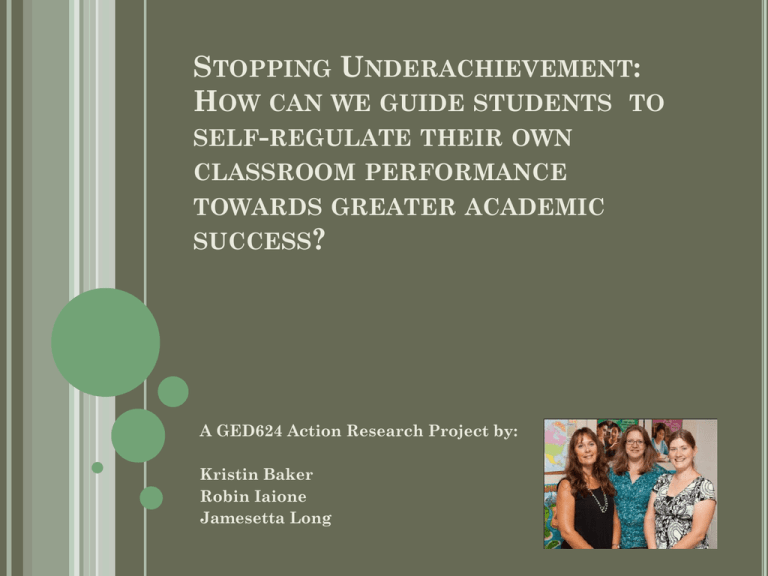
STOPPING UNDERACHIEVEMENT: HOW CAN WE GUIDE STUDENTS TO SELF-REGULATE THEIR OWN CLASSROOM PERFORMANCE TOWARDS GREATER ACADEMIC SUCCESS? A GED624 Action Research Project by: Kristin Baker Robin Iaione Jamesetta Long Metacognitive Self-Regulation as an Intervention for Underachievement Having observed an increasing number of students who do not work to ability and who seem excessively dependent on teacher direction, the authors propose a cyclical model of metacognitive self-regulation. Initially, teachers will establish the cyclical pattern through explicit instruction and modeling. Later, students will assume responsibility for applying metacognitive strategies and self-regulating their learning. “When good thinkers study a text, they feel a sense of investigation, a deep curiosity, and an insistence on being accurate. Although most of my students seemed to have the same ability to probe and discover the text why didn’t they?” (Costa, & Kallick, 2000). Have you noted an increase of the following behaviors in your students? Off task Just “get it done” attitudes Inability to sustain effective efforts Why are so many of our students satisfied with being simply “good enough”? Whether in general education or gifted classes, whether in academic or music studies, there are many students who simply do not seem to invest themselves in their work. A GROWING NUMBER OF STUDENTS STRUGGLE WITH SELF-REGULATION IN THE CLASSROOM. Underachievement in boys… “is currently a universal phenomenon which leads educators and parents to find ways to assuage this problem.” (Majzub,& Rais, 2010). We suspect that lack of self-regulation and lack of metacognition skills contribute to underachievement. Increasing student self-direction and teaching metacognitive strategies may improve academic success. The purpose of this action plan is to help students of mid to high ability whose classroom behaviors include two or more of the following: 1. Low scores/grades compared to potential ability and either 2. Dependent work habits (i.e. frequent requests for teacher clarification and reinforcement) or 3. Inability to effectively sustain on-task behavior (i.e., misdirected "rabbit trails," off-task behaviors) TEACHER SURVEYS INDICATE A SIGNIFICANT PROPORTION OF STUDENTS WHO SHOW SIGNS OF UNDERACHIEVEMENT. MAYBE YOU HAVE STORIES OF YOUR OWN… A young girl, recognized as a gifted writer, scores Below Proficiency on NJ ASK LAL. A boy, classified as gifted in mathematics, scores a “D” on a test, yet declines to correct his errors to raise his grade. A teacher, regarding issues of underachievement, says, “You mean, like what I see with my whole class?” We recognized that “it is not enough to be aware of one's understanding or failure to understand--a learner must be able to self-regulate his or her reading process in order to read for comprehension” (Collins, 1994). Focus Question: How can we help guide students to self-regulate their own classroom performance towards greater academic success? Goal Setting “STUDENTS MUST ASSUME INCREASING RESPONSIBILITY FOR PLANNING AND REGULATING THEIR LEARNING. IT IS DIFFICULT FOR LEARNERS TO BECOME SELF- DIRECTED WHEN LEARNING IS PLANNED AND MONITORED BY SOMEONE ELSE. STUDENTS CAN BE TAUGHT TO MAKE PLANS FOR LEARNING ACTIVITIES INCLUDING; ESTIMATING TIME REQUIREMENTS, ORGANIZING MATERIALS, AND SCHEDULING PROCEDURES NECESSARY TO COMPLETE AN ACTIVITY”. (BLAKELY & SPENCE, 1990) “Self-regulated learners are those who possess a systematic approach to their actions, including the acts of absorbing knowledge, mastering a performance, or thinking metacognitively” (Abromitis, 2010). Harris, Reid, and Graham (Reid, 2006), describe four cornerstones of self-regulation: goal setting self-monitoring self-instruction self-reinforcement. Self-instruction includes various forms of self-talk, such as internal monologue of problem-solving and self-praise. Journals, checklists, charts, providing written objectives, and goal setting are just some of the ways one can teach a student to stay on task and self regulate. Goal-setting is a key aspect of self-regulation and should be challenging yet attainable. “Setting goals that can be achieved with little or no effort will not increase a student's motivation; setting goals that are too difficult will be overwhelming for students,” (Reid, 2006). Siegle (2003) emphasizes the importance of student responsibility for identifying, managing, and rewarding goals: (Students should…) “Practice using goals by setting them, clarifying them, assessing them, developing methods for meeting them, and rewarding themselves for reaching them: self-consequating, self-encouraging, self-talk, self reward/consequence lists.” Students become empowered through managing their own goals, fostering self-efficacy. Goal Management Empowerment Self-Efficacy “EVEN THOUGH METACOGNITIVE STRATEGIES ARE CONSIDERED TO BE OF VALUE FOR ADEQUATE TEXT COMPREHENSION, CLASSROOM TEACHERS OFTEN FAIL TO TEACH THIS PROCESS” ( BOULWARE-GOODEN, CARREKER, THORNHIL, & MALATESHA, 2007). “I don’t know what to write,” stated one student while staring down at his essay question. “Where are you stuck?” asked the teacher who realized that the question was just discussed and explained at great length with the class. “I don’t know,” was his dull response as he continued to stare down at the blank paper, elbow on paper and hand on cheek with legs sprawled out. What went wrong? How does this student not know where to even begin? METAGOGNITIVE STRATEGIES Teachers use the process of thinking aloud, explaining their own thought process in all content areas. 1. Teachers model their own thought process to get students to begin to evaluate and implement their own thought processes… Teachers talk about thinking in a deliberate, thought-out manner. "Students need a thinking vocabulary (Blakely S. &Spencer S.) METACOGNITIVE STRATEGIES, CONT. 2. Students foster their own metacognition skills by explaining their thought process in small and large group setting… Paired problem solving… Students talk through a problem, describing their thinking processes. Partners listen to and ask questions to each other to help clarify thinking. WHY? "Children who observe a model similar to themselves are likely to believe that they can perform as well as the model and thereby experience higher self-efficacy" (Siegle, 2010) METACOGNITIVE STRATEGIES, CONT. 3. Students use recording devices to record their explanations so that they can hear how they responded. This helps them to develop their own process clarification. a. Audacity is a free online resource at http://audacity.sourceforge.net/. b. Handheld devices c. Classroom recorder 4. Students can keep a Process Journal, also called a “thinking journal.” The journal or "learning log" allows them to write down and reflect on their thought processes. This reflection process allows the student to be "aware of their own ambiguities and inconsistencies and comment on how they dealt with difficulties.” (Blakely & Spence, 2004) DID YOU KNOW?....... Underachievement has been linked to self-regulation for several decades. “While the ability to self-regulate has long been considered an essential part of a child’s healthy emotional development, self-regulation is increasingly being seen as a good predictor of a child’s academic success,”(Hoffman, 2010). Self-regulation was initially understood as self-control, "the ability to control one's own actions in the absence of immediate external constraints" (Bandura and Waiters, 1963; Thoresen and Mahoney, 1974; cited in Zimmerman, 1990). The term self-regulation was first defined by Bandura and Waiters (1963), to include standard-setting, self-evaluation, and self-reinforcement in addition to performance elements. Research on underachievement was often behavioral in scope, with interventions focused on increasing appropriate classroom behaviors such as time on task, (Goodlet and Goodlet,1969; Broden et al, 1971; cited in Zimmerman 1990). “THE MOST SUCCESSFUL PROGRAMS TO REVERSE UNDERACHIEVEMENT BEHAVIORS WILL PROVIDE A MENU OF INTERVENTION OPTIONS …(INCLUDING) SELF-REGULATION TRAINING ACTIVITIES” (SIEGLE, REIS ET AL, 2010). Targeting underachievement through metacognitive self-regulation… Our own classroom observations have led us to probe further into the qualitative aspects of time-on-task: Even “gifted students ” appear to be satisfied handing in work of mediocre to poor quality simply because it is “done.” It has been noted that when several underachievers are grouped together, the prevailing ethic becomes the “Gentleman’s C,” an informal teacher’s code for work completed quietly and in compliance with classroom routines, yet of fair quality, produced with minimal effort. Another troubling pattern is the capable yet dependent worker, who continually seeks affirmation or direction from the teacher instead of self-directing efforts to a clearly structured task. ADDITIONALLY RESEARCHERS HAVE NOTED THAT…. o “Guidance in recognizing, and practice in applying, metacognitive strategies will help students successfully solve problems throughout their lives” (Blakely, Spence 1990). o “Self-regulated learners are those who possess a systematic approach to their actions, including the acts of absorbing knowledge, mastering a performance, or thinking metacognitively” (Abromitis, 2010). o Journals, checklists, charts (providing written objectives), and goal setting are just some ways one can teach a student to stay on task and self regulate. o Zimmerman and Martinez-Pons (1986) identified 14 types of self-regulated learning strategies, many of which can be classified as metacognitive in nature. When evaluating students for evidence of these traits, they found a 93% correlation to advanced placement, evidencing successful achievement. “STUDIES SHOW THAT INCREASES IN LEARNING HAVE FOLLOWED DIRECT INSTRUCTION IN METACOGNITIVE STRATEGIES.” (SCRUGGS, 1985). “Since Flavell’s (1971) coining of the term metamemory, and especially since the seminal metacognition research of Flavell and Wellman (1977), many have investigated the phenomenon surrounding cognition about cognition,” (Cox, 2005). Researchers like Blakely and Spence elaborated on strategies introduced by Palinscar, Ogle, Jones, Carr, & Ransom in 1986 which highlighted ideas about “reciprocal teaching, paired problem solving, and teacher thinkalouds,” (Blakey & Spence, 1990). “Research examining the relationship between metacognitive skills and educational instruction have made significant progress. For example, Forrest-Pressley, MacKinnon, and Waller (1985) and Garner (1987) report successful instruction procedures related to both problem solving and reading comprehension (see also Ram and Leake 1995) (Cox, 2005). Articles and studies continued to give teachers a variety of strategies, established by a plethora of researchers. Is Self-Regulation simply controlling one’s behavior? Combining metacognition with self-regulation addresses the subjective, qualitative aspects of student learning. “Teachers need to focus student attention on how tasks are accomplished. Process goals, in addition to content goals, must be established and evaluated with students so they discover that understanding and transferring thinking processes improves learning, (Blakey & Spence 1990). Ghatala (1986, cited in Zimmerman, 1990) proposed that monitoring, a metacognitive process, is essential for effective implementation of self-regulation strategies. Zimmerman (1990) states, “Self-regulated learning occurs to the degree that a student can use personal (i.e., self) processes to strategically regulate his behavior and immediate learning environment through feedback loops. RECOMMENDED SOLUTION A TWO CYCLE PROCESS Time to Unpack Plan of Attack Time to Unpack Plan of Attack • Reflection & Outcome Monitoring • Forethought Preaction for guided selfregulation • Self Reflection • Self –Directed Goal Setting & Strategic Planning Are We On Track? •Performance Control Cycle 1: Explicit Instruction (Teacher Directed) Are We On Track? • Self-Regulated Performance Control Cycle 2: Practice in Process (Student Performed) RECOMMENDED SOLUTION A TWO CYCLE PROCESS Cycle One During Cycle I, the teacher provides explicit instruction and modeling in each of the three phases of metacognitive self-regulation. This first cycle will last for a full marking period, familiarizing students with the repeated cycling of the three phases, with each completed, processed task informing the planning for the next new challenge. RECOMMENDED SOLUTION A TWO CYCLE PROCESS Cycle Two Cycle II follows, as students are ready to assume responsibility for their own self-regulation. The teacher acts as “Guide on the Side,” coaching and providing support but continually urging the students to demonstrate self-efficacy. This second cycle is also one full marking period in duration. At the end of this second cycle, the students will have received half of an academic year of training and support aiming to increase self-regulation of their own learning. GUIDED METACOGNITION CYCLE ONE: PHASE ONE Time to Unpack • Reflection & Outcome Monitoring Plan of Attack •Forethought Preaction for guided selfregulation Are We On Track? •Performance Control Forethought – Teacher models thinkaloud of what do I know, what do I need to know; labels the thinking processes. Peer partners co-write Process Log after teacher modeling. GUIDED METACOGNITION CYCLE ONE: PHASE ONE Time to Unpack • Reflection & Outcome Monitoring Plan of Attack •Forethought Preaction for guided selfregulation Are We On Track? •Performance Control Preaction – Goal setting, forming a plan Teacher models how to break down a large task into small steps, identifying interim goals, selecting strategies. GUIDED METACOGNITION CYCLE ONE: PHASE TWO Peer practice of metacognition Time to Unpack • Reflection & Outcome Monitoring Plan of Attack • Forethought - Preaction for guided selfregulation Are We On Track? •Performance Control Reciprocal Teaching: Teacher directs Reciprocal Teaching, organizing turns and suggesting content. One student does the think-aloud; other acts as listener, prompting with steps, asking questions to clarify, summarizing. The listener’s prompts, praise and encouragement model effective self-talk (Blakey & Spence, 1990). Paired problem solving: Students talk through a problem while describing their thinking processes. Partners listen to and ask questions to help each other clarify thinking. "Children who observe a model similar to themselves are likely to believe that they can perform as well as the model and thereby experience higher selfefficacy" (Siegle, 2003). GUIDED METACOGNITION CYCLE ONE: PHASE TWO Performance monitoring and adjustment Time to Unpack • Reflection & Outcome Monitoring Plan of Attack • Forethought - Preaction for guided selfregulation Are We On Track? •Performance Control Teacher prompts students to check their progress and effectiveness of their strategies, using checklist or Process log. Teacher discusses adjustments of time frames, suggests appropriate rewards/consequences, such as 3 minute break, checking computation with calculator, etc. (All Kinds of Minds, 2010). GUIDED METACOGNITION CYCLE ONE: PHASE THREE Strategic Outcome Monitoring: Time to Unpack •Reflection & Outcome Monitoring Plan of Attack • Forethought - Preaction for guided selfregulation Are We On Track? •Performance Control Closure activities: "Debriefing the thinking process" (Blakey & Spence, 1990) Teacher models outcome monitoring (All Kinds of Minds, 2010) Examination of various strategies by which quality of completed work can be assessed: Rubric General checklist Check back on task guidelines GUIDED METACOGNITION CYCLE ONE: PHASE THREE Guided use of Process Log: o Time to Unpack •Reflection & Outcome Monitoring Plan of Attack • Forethought - Preaction for guided selfregulation Are We On Track? •Performance Control o Teacher guides discussion on effectiveness of process, leading students to identify what worked well and what needs adjustment for future tasks. Teacher provides direct instruction and modeling on use of the Process Log tool, including… Checklists Self-assessment "Notes to self" Suggested formats for Process Log: •Written notebook •Folder with notes, handouts, checklists •Digital audio: Handheld devices, Audacity software Selected format depends on classroom resources. SELF – DIRECTED METACOGNITION CYCLE TWO: PHASE ONE Forethought/Preaction… focuses on the content of the task (Siegle, 2003) Time to Unpack •Self Reflection Plan of Attack •Self-Directed goal setting & Strategic Planning Are We On Track? •Self-Regulated Performance Control Determine goals Break up larger goals into smaller attainable ones Estimate time requirements, set time frame for short-term objectives Plan interim selfrewards/consequences to support adherence to time frame SELF – DIRECTED METACOGNITION CYCLE TWO: PHASE ONE Time to Unpack •Self Reflection Plan of Attack •Self-Directed goal setting & Strategic Planning Are We On Track? •Self-Regulated Performance Control Strategic Planning focuses on where, when, and how tasks will be addressed What resources/processes are needed? Schedule procedures; organize materials; structure environment SELF – DIRECTED METACOGNITION CYCLE TWO: PHASE TWO Metacognitive strategy implementation and monitoring – Is the task proceeding according to plan? (NRC/GT, 2010) Time to Unpack • Self Reflection Plan of Attack • Self – Directed Goal Setting & Strategic Planning Students use… Are We On Track? •Self-Regulated Performance Control Process Logs, checklists to monitor effectiveness of goals, plans, and strategies Self-talk, including selfrewards, self-consequences, plan adjustments Resources, peers, environment appropriately as supports to task completion. SELF – DIRECTED METACOGNITION CYCLE TWO: PHASE TWO Behavioral self-regulation: Are objectives accomplished on schedule? If not, check... Time to Unpack • Self Reflection Plan of Attack • Self – Directed Goal Setting & Strategic Planning Are We On Track? •Self-Regulated Performance Control Is there distraction? Time management? (perseveration, or rushing through and then needing to go back and "fix") Problems with working conditions (environment)? Can problem be corrected or is change of venue needed? SELF – DIRECTED METACOGNITION CYCLE TWO: PHASE THREE Outcome monitoring: evaluating product (All Kinds of Minds, 2010) Time to Unpack • Self Reflection Plan of Attack • Self – Directed Goal Setting & Strategic Planning Are We On Track? •Self-Regulated Performance Control Recall strategies used What worked to support task completion? What did not support task completion? Evaluate quality of work completed What worked to support task quality? What did not support task quality? SELF – DIRECTED METACOGNITION CYCLE TWO: PHASE THREE Process Log (Blakey & Spence, 1990) Time to Unpack • Self Reflection Plan of Attack • Self – Directed Goal Setting & Strategic Planning Are We On Track? •Self-Regulated Performance Control Identify and classify strategies, evaluate effectiveness Notes-to-self for future tasks 1:1 Student-teacher conferences to discuss Process Log and review outcomes POTENTIAL IMPACT Anticipated changes in classroom behaviors: Having implemented metacognitive selfregulation skills in the classroom students will be able to utilize their own thinking skills to process questions, thoroughly respond to questions, and stay on task. Alignment with curriculum: Our plan works along with all content curriculum. Following through on metacognitive self regulation skills enhances understanding and application of skill sets entrenched in curriculum. IMPLEMENTATION PLAN Potential incentives: Students will gain awareness of their own ability to selfregulate during tasks and to evaluate and synthesize concepts. This accomplishment alone is the reward. Teachers will benefit from students’ greater independence. Costs: There are no costs involved in the implementation of this plan. Dedicated time and consistency of practice are necessary for effective implementation. IMPLEMENTATION PLAN: Measuring Effectiveness: Results of this Action Plan can be noted via both formative and summative classroom assessments. This includes: quizzes, tests, rubrics for various projects and writing assignments, and portfolios which would include the work from the student showing progress. The original teacher survey will be distributed again after the conclusion of the program (two marking periods). Results of this questionnaire will help the research committee make conclusions about the success of the implemented solution. ANTICIPATED OUTCOME WHAT RESULTS MAY OCCUR? Short-term, proximal results in student behaviors within the school year Increased student autonomy and enhanced performance outcomes in classroom tasks Increased standardized test scores, as a positive consequence of heightened awareness and selfevaluation strategies Classroom practice is transformed into a model centering on student responsibility. The teacher will guide the students to plan, to explore, and to assess their own learning. ANTICIPATED OUTCOME HOW WILL THE CURRICULUM CHANGE? Instructional practices may shift to greater student empowerment, such as student-designed projects or self-directed study times. An increase in student self-monitored activities such as… Student-centered investigations Student-shaped study practice RESOURCES _____. Self regulating learning. (n.d.). Retrieved October 2010 from http://www.allkindsofminds.org/learningBaseSubSkill.aspx?lbssid=104 _____. (2010). “Diving in Deeper”: Bringing basic writers’ thinking to the surface. Journal of Adolescent & Adult Literacy , doi:10.1598/JAAL.53.8.5, (pp. 668–676). Abromitis, B. (2010). Promoting self-regulated learning in elementary aged children. Retrieved from http://www.suite101.com/content/promoting-selfregulated-learning-in-elementary-aged-children-a212513#ixzz12CAm3iP7 Allday, R., & Pakurar, K. (2007). Effects of Teacher Greetings on Student OnTask Behavior. Journal of Applied Behavior Analysis, 40(2), 317-320. Arritola, K., Breen, J., & Paz, E. (2009, May 1). Increasing On-Task Behavior through the Development of Classroom Social Skills. Baker, L. (n.d.). Metacognition. Retrieved from http://www.education.com/reference/article/metacognition/#A RESOURCES Baugous, K., & Bendery, S. (2000, May 1). Decreasing the Amount of Classroom Disruptions in Order To Increase the Amount of Time on Task in Elementary Students. Blakely, E. & Spence E..(1990.). Developing Metacognition:Thinking for the Future, excerpted in Emergency Librarian, 17(5), May-June 1990, 11-14. Retrieved October 2010 from http://www.education.com/reference/article/Ref_Dev_Metacognition/ Boulware-Gooden, R, Carreker, S, & Thornhil, A, Malatesha Joshi, R. (2007). Instruction of metacognitive strategies enhances reading comprehension and vocabulary achievement of third-grade students. Reading Rockets, Retrieved from http://www.readingrockets.org/article/21160#strategies Chiu, M. (2004). Adapting Teacher Interventions to Student Needs during Cooperative Learning: How to Improve Student Problem Solving and Time On-Task. American Educational Research Journal, 41(2), 365-399. Clements, D. H., & Nastasi, B.K. (1999). Metacognition, Learning, and Educational Computer Environments. Information Technology in Childhood Education Annual, Retrieved from http://www.highbeam.com/doc/1G1-72984158.html Coil, Carolyn. The Hidden Gifted Underachiever. E-zine Vol.2, No. 4; retrieved October 2010 from http://www.carolyncoil.com/ezine24.htm RESOURCES Collins, N.D. (1994). Metacognition and reading to learn. Eric Digest, ED376427 . Retrieved from http://www.ericdigests.org/1995-2/reading.htm Costa, A. L., & Kallick, B. (2000). Activating & engaging habits of mind. Alexandria, VA: Association for Supervision and Curriculum Development. Cox, M.T. (2005). Metacognition in computation: a selected research review. JournalArtificial Intelligence, 169(2), Retrieved from http://portal.acm.org/citation.cfm?id=1644571 Hoffman, Todd. (2010). Self Regulation: The Key to Successful Students? Retrieved October 2010 from http://www.education.com/magazine/article/self-regulation-children/. Martin, Garry. Behavior Modification: What It Is and How to Do It. Englewood Cliffs, NJ: Prentice-Hall, 1988, cited in Encyclopedia of Mental Disorders, retrieved November 2010 from http://www.minddisorders.com/A-Br/Behavior-modification.html. McDevitt|, T.M., & Ormrod , J.E. (n.d.). Developmental trends: cognitive strategies and metacognition at different age levels. Pearson Allyn Bacon Prentice Hall. Retrieved from http://www.education.com/reference/article/developmental-cognitive-different-age/ Mendenhall, A., & Johnson, T. (2010). Fostering the Development of Critical Thinking Skills, and Reading Comprehension of Undergraduates Using a Web 2.0 Tool Coupled with a Learning System. Interactive Learning Environments, 18(3), 263-276. Retrieved from ERIC database. RESOURCES Nash-Ditzel, Initials. (2010). Metacognitive reading strategies can improve self regulation. Journal of College Reading and Learning, 40, 45-63. Pelco, Lynn E.; Reed-Victor, Evelyn. Self-Regulation and Learning-Related Social Skills: Intervention Ideas for Elementary School Students. Preventing School Failure, v51 n3 p3642 Spr 2007. Reid, Bob. (2006).Cognitive Strategy Instruction: Self Regulation. UNL: Dept. of Special Ed and Communication Disorders. Retrieved October 2010 from http://www.unl.edu/csi/self.shtml. Reis, Sally M. Underachievement of Gifted Students: Many Frustrations and Few Solutions. Retrieved October 2010 from oagct.org/wpcontent/uploads/droppingoutwithdignity.doc Reis, S. & McCoach, D. The underachievement of gifted students: What do we know and where do we go? Gifted Child Quarterly (NAGC) Vol. 44, No. 3, pp. 152-170. Summer 2000 Siegle, D. (2003).Using the achievement-orientation model to reverse underachievement. NRC:GT at University of CT, Storrs. Retrieved from http://selfregulation.pbworks.com/f/MotivationHandout.pdf Siegle, D. Reis, Sally M., and others. Self-Regulation Module. Neag Center for Gifted Education and Talent Development, NRC: GT, Univ CT, Storrs. Retrieved October 2010 from www.gifted.uconn.edu/siegle/SelfRegulation/printversion.pdf. RESOURCES Zimmerman, B. J. (1990). Self-regulated academic learning and achievement: The emergence of a social cognitive perspective. Educational Psychology Review, 2, 173-201. Zimmerman, B. J., Bonner, S., & Kovach, R. (1996). Developing self-regulated learners: Beyond achievement to self-efficacy. Washington, DC: American Psychological Association
